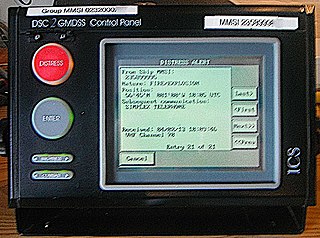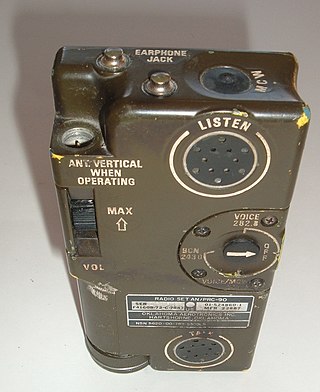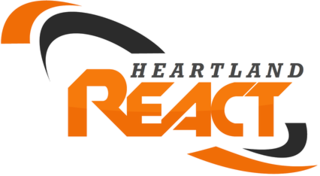Related Research Articles

Citizens band radio, used in many countries, is a land mobile radio system, a system allowing short-distance one-to-many bidirectional voice communication among individuals, using two-way radios operating near 27 MHz in the high frequency or shortwave band. Citizens band is distinct from other personal radio service allocations such as FRS, GMRS, MURS, UHF CB and the Amateur Radio Service. In many countries, CB operation does not require a license, and may be used for business or personal communications.

An emergency position-indicating radiobeacon (EPIRB) is a type of emergency locator beacon for commercial and recreational boats, a portable, battery-powered radio transmitter used in emergencies to locate boaters in distress and in need of immediate rescue. In the event of an emergency, such as a ship sinking or medical emergency onboard, the transmitter is activated and begins transmitting a continuous 406 MHz distress radio signal, which is used by search-and-rescue teams to quickly locate the emergency and render aid. The signal is detected by satellites operated by an international consortium of rescue services, COSPAS-SARSAT, which can detect emergency beacons anywhere on Earth transmitting on the distress frequency of 406 MHz. The satellites calculate the position or utilize the GPS coordinates of the beacon and quickly passes the information to the appropriate local first responder organization, which performs the search and rescue. As Search and Rescue approach the search areas, they use Direction Finding (DF) equipment to locate the beacon using the 121.5 MHz homing signal, or in newer EPIRBs, the AIS location signal. The basic purpose of this system is to help rescuers find survivors within the so-called "golden day" during which the majority of survivors can usually be saved. The feature distinguishing a modern EPIRB, often called GPIRB, from other types of emergency beacon is that it contains a GPS receiver and broadcasts its position, usually accurate within 100 m (330 ft), to facilitate location. Previous emergency beacons without a GPS can only be localized to within 2 km (1.2 mi) by the COSPAS satellites and relied heavily upon the 121.5 MHz homing signal to pin-point the beacons location as they arrived on scene.
A distress signal, also known as a distress call, is an internationally recognized means for obtaining help. Distress signals are communicated by transmitting radio signals, displaying a visually observable item or illumination, or making a sound audible from a distance.

The Family Radio Service (FRS) is an improved walkie-talkie radio system authorized in the United States since 1996. This personal radio service uses channelized frequencies around 462 and 467 MHz in the ultra high frequency (UHF) band. It does not suffer the interference effects found on citizens' band (CB) at 27 MHz, or the 49 MHz band also used by cordless telephones, toys, and baby monitors. FRS uses frequency modulation (FM) instead of amplitude modulation (AM). Since the UHF band has different radio propagation characteristics, short-range use of FRS may be more predictable than the more powerful license-free radios operating in the HF CB band.

The General Mobile Radio Service (GMRS) is a land-mobile FM UHF radio service designed for short-range two-way voice communication and authorized under part 95 of the US FCC code. It requires a license in the United States, but some GMRS compatible equipment can be used license-free in Canada. The US GMRS license is issued for a period of 10 years by the FCC. The United States permits use by adult individuals who possess a valid GMRS license, as well as their immediate family members. Immediate relatives of the GMRS system licensee are entitled to communicate among themselves for personal or business purposes, but employees of the licensee who are not family members are not covered by the license. Non-family members must be licensed separately.

Marine VHF radio is a worldwide system of two way radio transceivers on ships and watercraft used for bidirectional voice communication from ship-to-ship, ship-to-shore, and in certain circumstances ship-to-aircraft. It uses FM channels in the very high frequency (VHF) radio band in the frequency range between 156 and 174 MHz, inclusive, designated by the International Telecommunication Union as the VHF maritime mobile band. In some countries additional channels are used, such as the L and F channels for leisure and fishing vessels in the Nordic countries. Transmitter power is limited to 25 watts, giving them a range of about 100 kilometres.
The Global Maritime Distress and Safety System (GMDSS) is a worldwide system for automated emergency signal communication for ships at sea developed by the United Nations' International Maritime Organization (IMO) as part of the SOLAS Convention.

Digital selective calling or DSC is a standard for transmitting predefined digital messages via the medium-frequency (MF), high-frequency (HF) and very-high-frequency (VHF) maritime radio systems. It is a core part of the Global Maritime Distress Safety System (GMDSS).
In the United States, the business band is the colloquial name used by radio users who utilize, and scanner hobbyists who listen to, the Federal Communications Commission (FCC) Industrial/Business pool frequencies. The regulations listing frequencies in this pool are contained in Subpart C of Part 90, Title 47 of the CFR.

PMR446 is a licence-exempt service in the UHF radio frequency band and is available for business and personal use in most countries throughout the European Union.
Shortwave bands are frequency allocations for use within the shortwave radio spectrum. Radio waves in these frequency ranges can be used for very long distance (transcontinental) communication because they can reflect off layers of charged particles in the ionosphere and return to Earth beyond the horizon, a mechanism called skywave or “skip” propagation. They are allocated by the ITU for radio services such as maritime communications, international shortwave broadcasting and worldwide amateur radio. The bands are conventionally named by their wavelength in metres, for example the ‘20 meter band’. Radio propagation and possible communication distances vary depending on the time of day, the season and the level of solar activity.

The International Cospas-Sarsat Programme is a satellite-aided search and rescue (SAR) initiative. It is organized as a treaty-based, nonprofit, intergovernmental, humanitarian cooperative of 45 nations and agencies. It is dedicated to detecting and locating emergency locator radio beacons activated by persons, aircraft or vessels in distress, and forwarding this alert information to authorities that can take action for rescue. Member countries operate a constellation of around 66 satellites orbiting the Earth which carry radio receivers capable of locating an emergency beacon anywhere on Earth transmitting on the Cospas-Sarsat frequency of 406 MHz.
Amateur radio frequency allocation is done by national telecommunication authorities. Globally, the International Telecommunication Union (ITU) oversees how much radio spectrum is set aside for amateur radio transmissions. Individual amateur stations are free to use any frequency within authorized frequency ranges; authorized bands may vary by the class of the station license.

The radio frequency 2182 kHz is one of the international calling and distress frequencies for maritime radiocommunication in a frequency band allocated to the mobile service on first priority ("primary") basis, exclusively for distress and calling operations.

In navigation, a radio beacon or radiobeacon is a kind of beacon, a device that marks a fixed location and allows direction-finding equipment to find relative bearing. But instead of employing visible light, radio beacons transmit electromagnetic radiation in the radio wave band. They are used for direction-finding systems on ships, aircraft and vehicles.

Survival radios are carried by pilots and search and rescue teams to facilitate rescue in an emergency. They are generally designed to transmit on international distress frequencies. Maritime systems have been standardized under the Global Maritime Distress Safety System.Civil and military organisation's utilized different frequencies to communicate and no infringement on either sector would take place. For emergencies involving civilian aircraft, the radio frequency used is VHF 121.5 MHz and for military aircraft incidents, the frequency used is UHF 243 MHz.

Heartland REACT was a chapter of REACT International based in Omaha, Nebraska. It was founded in 1967 as Douglas County REACT and incorporated as a non-profit organization in 1972 to provide communications as a public service in the event of emergency and non-emergency events around the Omaha metro area. The Omaha chapter of REACT International was dissolved in 2021 and the organization was reformed as Heartland READY.

A personal radio service is any system that allows individual to operate radio transmitters and receivers for personal purposes with minimal or no special license or individual authorization. Personal radio services exist around the world and typically use light-weight walkie talkie portable radios. The power output, antenna size, and technical characteristics of the equipment are set by regulations in each country. Many regions have standardized personal radio service rules to allow travelers from one country to use their equipment in another country. Examples of standardized services include PMR446 and FM Citizens Band Radio (CB) in the EU and several other countries/regions. 26–27 MHz CB radio is the oldest personal radio service and is used in nearly every country worldwide, with many countries and regions copying the United States 40-channel frequency plan. In many countries, CB radio is less popular due to the availability of other personal radio services that offer shorter antennas, better protection from noise and interference.
The Cyprus Joint Rescue Coordination Center or JRCC Larnaca is an independent agency of the Ministry of Defence of the Republic of Cyprus and its primary mission is to organize the national Search and Rescue (SAR) system, to co-ordinate, to control and direct SAR operations in the region that the Cyprus JRCC is responsible for, so that people, whose lives are at risk as a result of aviation or maritime accidents, can be located and rescued in the least amount of time.
An emergency locator beacon is a radio beacon, a portable battery powered radio transmitter, used to locate airplanes, vessels, and persons in distress and in need of immediate rescue. Various types of emergency locator beacons are carried by aircraft, ships, vehicles, hikers and cross-country skiers. In case of an emergency, such as the aircraft crashing, the ship sinking, or a hiker becoming lost, the transmitter is deployed and begins to transmit a continuous radio signal, which is used by search and rescue teams to quickly find the emergency and render aid. The purpose of all emergency locator beacons is to help rescuers find survivors within the so-called "golden day", the first 24 hours following a traumatic event, during which the majority of survivors can usually be saved.
References
- ↑ Bartlett, Tim (2006). VHF Handbook. Southampton: The Royal Yachting Association. pp. 28, 31. ISBN 978-1-905104-03-1.
- ↑ "Logon Form". www.piersystem.com.
- ↑ "Logon Form". www.piersystem.com.
- ↑ "USCG: Commercial Fishing Vessel Safety Program - 13th Coast Guard District - Guardians of the Pacific Northwest". www.uscg.mil.
- ↑ UK Hydrographic Office (2017). Volume 1 (NP281) - Maritime Radio Stations (Parts 1 & 2). UK: UK Hydrographic Office.
- 1 2 "HF Distress and Safety Watchkeeping Schedule". U.S. Coast Guard Navigation Center. U.S. Coast Guard. Retrieved Oct 12, 2011.
- ↑ "Recommendation M.541: Operational procedures for the use of digital selective-calling equipment in the maritime mobile service". International Telecommunication Union. 2015.
- ↑ "ARRL Band Plans".
- ↑ https://ntc5.ntc.gov.ph/wp-content/uploads/2019/09/mc-04-03-2011-authorizing-the-use-of-RF-in-times-of-emergency.pdf [ bare URL PDF ]
- ↑ "IARU Emergency Telecommunications Guide" (PDF). Archived from the original (PDF) on 2018-09-20.
- ↑ "Emergency Center of Activity Frequencies adopted by the IARU Region 1 General Conference 2005" (PDF). Archived from the original (PDF) on 2018-11-14.
- ↑ Ulli, DK4VW - (16 May 2023). "HF - International Amateur Radio Union - Region 1". iaru-r1.org.
- ↑ "Archived copy" (PDF). Archived from the original (PDF) on 2013-04-08. Retrieved 2013-05-06.
{{cite web}}: CS1 maint: archived copy as title (link) - ↑ "Archived copy" (PDF). Archived from the original (PDF) on 2013-04-08. Retrieved 2013-05-06.
{{cite web}}: CS1 maint: archived copy as title (link) - ↑ INC, copyright 2007 HFPACK. "HFLINK - HF Automatic Link Establishment HF ALE HF Network Ham Radio Amateur Radio HF Emergency Disaster Relief Communications". hflink.com.
- ↑ "SHTF Survialist Radio Frequency Lists". 29 June 2013.
- ↑ "ACMA Fact Sheet: Citizen band radio".